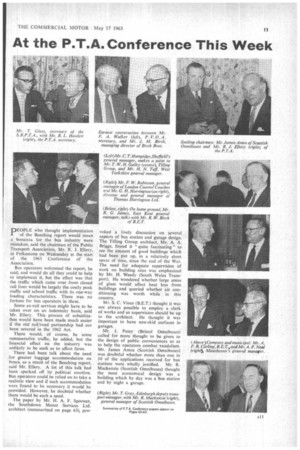At the P.T.A. Conference This Week
Page 13

If you've noticed an error in this article please click here to report it so we can fix it.
PEOPLE who thought implementation I of the Beeching report would mean a bonanza for the bus industry were mistaken, said the chairman of the Public Transport Association, Mr. R. J. Ellery, in Folkestone on Wednesday at the start of the 1963 Conference of the Association.
Bus operators welcomed the report, he said, and would do all they could to help to implement it, but the effect was that the traffic which came over from closed rail lines would be largely the costly peak traffic and school traffic with its one-way loading characteristics. There was no fortune for bus operators in these.
Some ex-rail services might have to be taken over on an indemnity basis, said Mr. Ellery. This process of subsidization would have been made much easier if the old rail/road partnership had not been severed in the 1962 Act.
There would, of course, be some remunerative traffic, he added, but the financial effect on the industry was unlikely to be such as to affect fares.
There had been talk about the need
• for greater luggage accommodation on buses, as a result of the Beeching report, said Mr. Ellery. A lot of this talk had been sparked off by political emotion, Bus operators could be relied on to take a realistic view and if such accommodation were found to be necessary it would be provided. However, he doubted whether there would be such a need.
The paper by Mr. H. A. F. Spooner, the Southdown Motor Services Ltd. architect (summarized on page 63), pro yoked a lively discussion on several aspects of bus station and garage design. The Tilling Group architect, Mr. A. A. Briggs, found it "quite fascinating" to see the amount of good buildings which had been put up, in a relatively short space of time, since the end of the War. The need for adequate supervision of work on building sites was emphasized by Mr. H. Weedy (South Wales Transport). He wondered whether large areas of glass would affect heat loss from buildings and queried whether 'air conditioning was worth while in this country.
Mr. S. C. Vince (B.E.T.) thought it was not always possible to employ a clerk of works and so supervision should be up to the architect, He thought it was important to have non-skid surfaces in garages.
Mr. I. Patey (Bristol Omnibuses) called for more thought to be given to the design of public conveniences so as to help the operators combat vandalism. Mr. James Amos (Scottish Omnibuses) was doubtful whether more than one in 10 of the applications received for bus stations were wholly justified. Mr. R. Mackenzie (Scottish Omnibuses) thought the most economical design was a building which by day was a bus station and by night a garage.












































































































